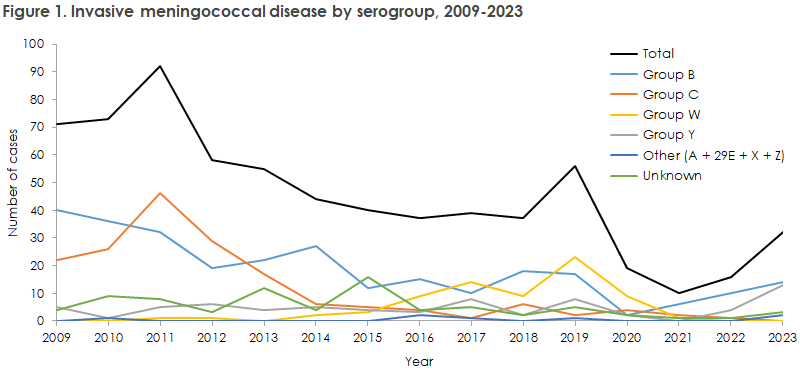No 11/12b - 2024
Meningococcal disease in 2023
Meningococcal disease in 2023
- In 2023, the occurrence of invasive meningococcal disease approached the levels observed in the period leading up to the COVID-19 pandemic.
- A total of 32 cases of invasive meningococcal disease (MD) were registered, which is twice the 16 cases recorded in 2022, but below the annual number notified before the COVID-19 pandemic.
- In 2022, group B was dominant. In contrast, 2023 recorded an increase in the number of group Y cases. Thus, nearly the same number of group B and group Y cases were recorded in 2023.
- Due to the increase in the number of group Y cases, attention should be devoted to establishing if vaccination against group ACWY and/or group B is indicated in connection with prophylactic vaccination.
For a detailed description of the incidence, please see the 2023 annual report on invasive meningococcal disease.
MD is a list 1a condition cf. Executive Order on Notification of Infectious Diseases (retsinformation.dk) and is therefore notifiable by phone and in writing to the Danish Patient Safety Authority and Statens Serum Institut, see Sygdomsovervågning (ssi.dk) in Danish language for more information about disease monitoring. The duty to notify serves, among others, to ensure rapid infection tracing to prevent secondary cases in close contacts through treatment with antibiotics and, when relevant, vaccination, see Guideline on prevention in case of meningococcal disease (retsinformation.dk), in Danish language. It is important to submit the sample to Statens Serum Institut for grouping and, if relevant, to offer relevant vaccinations to close contacts, see Invasive meningococcal disease, post-exposure prophylaxis (ssi.dk), in Danish language.
In the years leading up to the pandemic, MD occurrence plateaued at approx. 40 annual cases, even though a steep increase caused by group W was recorded in 2019. Concurrently with the introduction of restrictions to limit infection with SARS-CoV-2 in 2020, a considerable decline was recorded, which continued in 2021 and 2022. Year 2023 witnessed a doubling of the number of cases, and we are now approaching the level seen before the COVID-19 pandemic, Figure 1. In 2023, the number of meningococcal cases of group Y increased. Therefore group B (14) and group Y (13) now account for nearly the same number of cases. In 2023, group Y was detected mainly in patients aged > 40 years. However, a total of four group Y cases were recorded in patients aged 14-29 years. Group B was detected in nearly all age groups. In connection with vaccination against meningococcal disease, this should be kept in mind when assessing if vaccination against group B and/or vaccination against group AWCY is indicated.

One adult patient died due to MD in 2023, and five persons had late sequelae to MD registered; hearing loss was the most frequently reported sequela. In 18 of the persons (56%), one or more underlying diseases had been recorded ahead of MD, among which cancer and pulmonary conditions were the most frequently occurring.
(N. Filipsen, B. Søborg, Department of Infectious Disease Epidemiology and Prevention, S. Hoffmann, Department of Bacteria, Parasites and Fungi)
20 March 2024